As one who succumbed to the so-called “middle-age spread” long before I actually reached middle age, one would think that I have little room [sic] to talk about bloating. But I can, because I’m not talking about people here, but cars.
Let me get this right out of the way first: I don’t like big cars. I’m not just talking about Cadillacs or SUVs here, which is a whole ‘nother rant; I’m talking about how ordinary, nay even small cars, seem to have ballooned out of all proportion — turning what was once a small car into something close to a medium-sized one. And cars were small back then; here’s a late-1950s Alfa Romeo Giulietta next to its owner (who looks like a giant, but only by comparison):
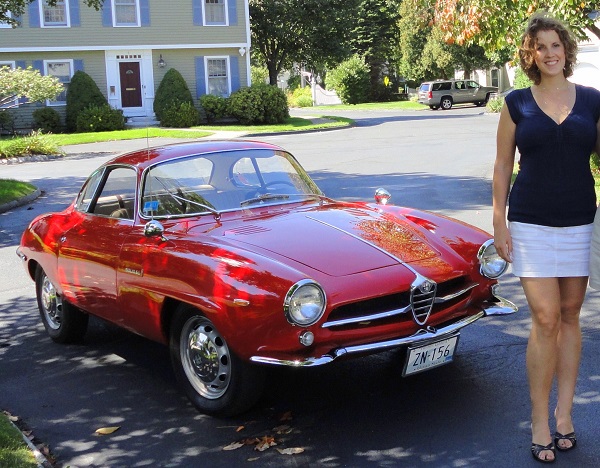
…and a 1955 Lancia Aurelia B24 ditto:
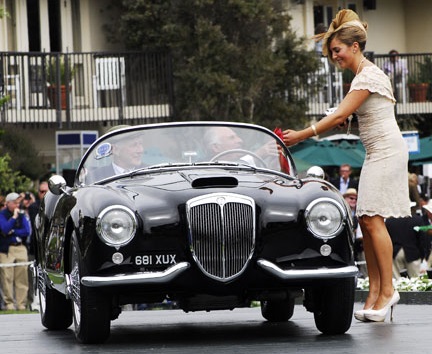
Alas, those lovely little cars are long gone and out of production; but others are still with us, albeit bloated versions of their former selves. Allow me to post a couple of pics to illustrate the point.
When Britain introduced the Mini to the world, it was a brilliant small car not only for its design but for its utility. Tiny, nimble and quick (even with its teeny 850cc engine), the Mini was the perfect city car for the time (1960s and 70s), and the ads and pics reflected the car’s ethos to a nicety. Note this one, featuring a very Swinging Sixties sex symbol, Charlotte Rampling:
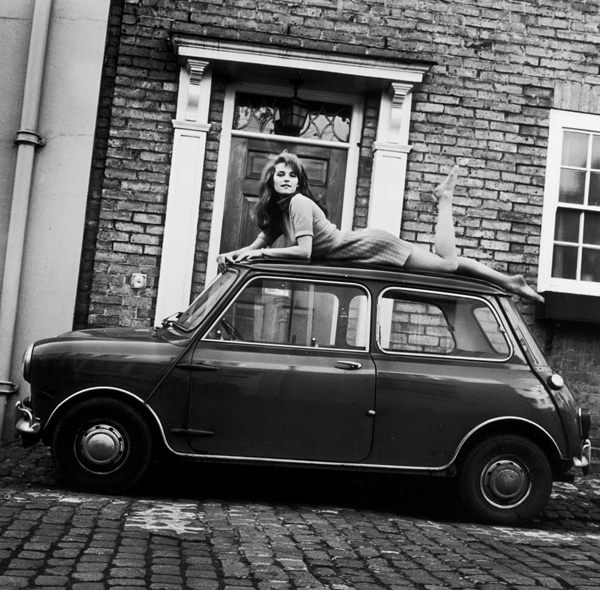
Note its setting: some backstreet mews in (I suppose) London, maybe even one near the iconic Carnaby Street.
But look at what the German BMW-spawned Mini has become, by comparison to its predecessor:
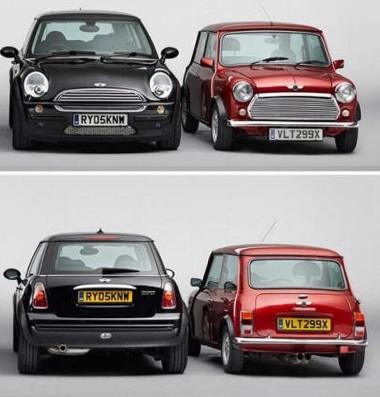
Now I know that a lot of the bloat has come about because of the Nanny State’s insistence on airbags and similar safety features [25,000-word rant deleted] and the fact that in today’s obese world of fatties and such, only anorexic supermodels could get in and out of the old Mini without needing the Jaws Of Life. I know all that, and I don’t accept the excuse, because back in the 1970s I knew a 6’11” tall man who used a Mini as his daily driver, and I , at ~230lbs, used to hell around with him when clubbing and so on. Was it a tight fit (as the actress asked the bishop)? Sure it was: but we weren’t driving thousands of miles either, so temporary discomfort was quite acceptable.
Here’s another example of bloat. After WWII, FIat came up with a cheap, tiny car with an even smaller engine (479cc, later 499cc) than the Mini’s: the fabled Quinquecento (500) — the later version of which, the 600, was actually marketed as a family car despite being if anything, slightly smaller than the Mini was. Like the Mini, however, the 500/600 was mostly marketed as a single person’s car (and especially for young women):
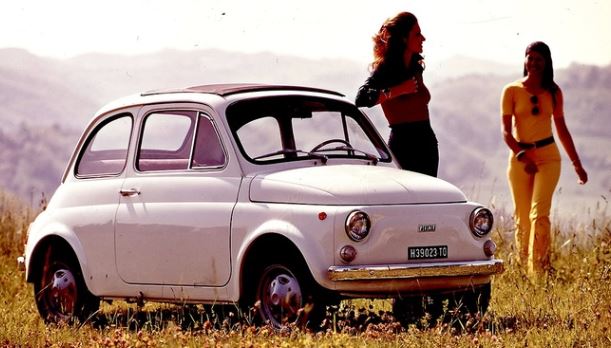
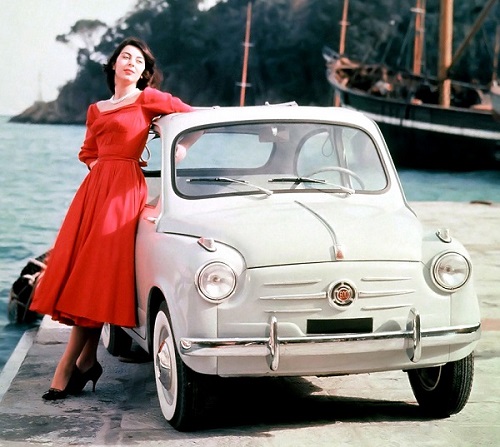
Unlike many, I have actually driven one of these pint-sized creations — no small feat in that I was a 50-gallon-sized guy, even back then — and my gripe was not about the dimensions but about the crappy little engine.
I have since driven one of the new Fiat 500s, by the way (Daughter has one) and I love it despite its crappy little engine — some things never change* — but again as with the Mini, the new one is a bloated fat cow by comparison:
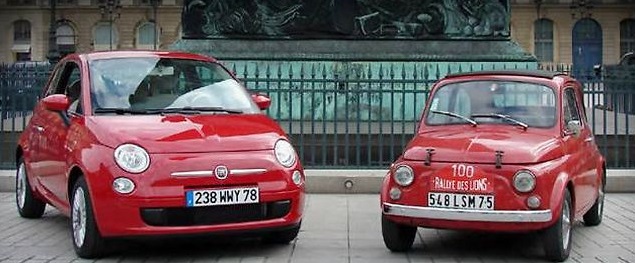
And note the not-so-subtle change in Fiat’s marketing:
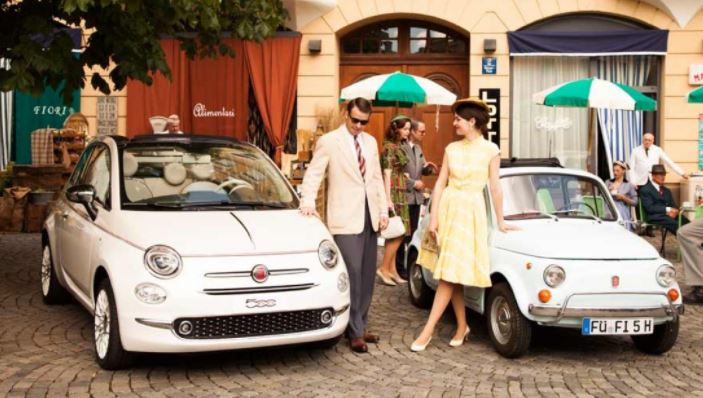
Are the New Fatties better cars than their tiny predecessors? Of course they are. Times have changed, and engineering has improved. But with all that improvement, some character — okay, a lot of character — has been lost along the way, and I, for one, lament its passing.
I seem to do that a lot these days. Gah.
*I’ve been in the Fiat 500 Abarth, by the way — Longtime Friend Knob drove me around Monaco in his a month ago — and it is a monster: it’s like a pocket-sized Ferrari. And don’t get me started on how Ferraris have got wider and fatter either, or we’ll be here for a week.


Careful Kim, you’re talking about First World concerns. Some “progressive” visitor’s head is going to explode. Lol.
usmc,
My entire website is dedicated to First World concerns, a.k.a. “Western Civilization”, and I’m working like hell to preserve it.
My first car at 17 years old was a 1958, Austin Healy, Bug-Eye, Sprite which was a small, small car, rather basic with no windows, not much of a top, etc. I had earned enough money to buy a BSA motorcycle and my dad said no, he would help me a bit to buy a car, a car which was not much safer than a motorcycle but a hell of a lot of fun on corners. I had a handful of the Brit sport cars over the years and they were small, low, fast and fun, lots of fun to work on as they fell apart as they were being driven.
My advice years ago if a person wanted the experience of a British sports car was to buy and nice Jap sports car, put a couple of wet chamois under the seats and let them mildew, for the smell, keep small jar with a few cotton balls dabbed with gasoline, for the smell and burn a little section of electrical wire with a cigarette lighter once a week for the smell. Then weekly pour a 1/4 cup of motor oil on the driveway or on the floor of the garage, have a neighbor randomly slightly pull a wire loose under the hood (bonnet), and from time to time punch a new hole in the muffler to increase the engine noise and let some exhaust up into the passenger compartment. Always leave the windows down a couple of inches during heavy rain storms to allow fresh air in and a nice sprinkling of water that will turn sour when the skies clear and the interior heats up. I guess the last thing would be to cover half the radiator with cardboard so the car will start to overheat at stop lights requiring turning the engine off until the light turns green once more.
That should do it, all that being said I loved real driving and messing around with those small, old cars, Austin Healy, Triumph and Jaguar with genuine Lucas electrical parts. Yep, very much like my ex-wife, great to look at, wonderful fun when everything was going right and trying to kill me when they were not.
During my tour of duty in Spain, (1977-80) I watched Lucas Electrick equipped cars reduce strong men to tears. (Strong men that worked on sophisticated aircraft electronics systems no less.)
And I’ve managed to get myself, Future Ex-Wife, two kids and a week’s supply of groceries in a SEAT 600. Granted , Future Ex-Wife was petite and kids were pre-schoolers, but still…
When I was young and sort of foolish I was the proud owner of a 67 Sunbeam Tiger. The Maxwell Smart Car. It was the best and worst of American and British engineering. The 260 small block Ford engine was dead solid reliable and easy to maintain. I felt that the car was fast enough to scare me, but if I still owned it I’d probably swap the engine out for a 289 with all of the good speed parts – or leave it alone because an “original all parts matching” Tiger is worth quite a bit today. My gripe was the Girling hydraulic system and the Lucas electrics. I learned that the British drink warm beer because their refrigerators are made by Lucas. The top leaked and the car rattled and when I got married in 1976 Momma’s disapproving looks about the puddle in her lap every time it rained pointed me in the direction of a “real” car. Since then I’ve owned a bunch of cars – some were great and some not – but that Tiger is the only car I regret selling and I wish that I still had it today.
Fie on that! I had a Mazda Miata as a daily driver for 13 years. All the fun of a British sports car, none of the drama.
I’ve never really been a “car guy” – trucks and motorcycles were more my thing. Sad to say, the “bloat” has affected them as well.
Just for an example, take a look at a typical pickup from the 1950’s and compare it to a modern truck. The modern truck is gargantuan by comparison. In fact, modern day “compact” trucks like the Toyota Tacoma and Chevy Colorado, are closer in dimension to the “full size” trucks of the 1950’s and 60’s than they are to the full size trucks of today.
Ditto for motorcycles. When I started riding in 1982, my first bike was a 450cc, which I felt was impressively large and powerful (considering that in most countries outside of North America, a 250cc is considered to be a “big bike” and most people get along fine on 175cc and smaller machines, it was.)
In those days, a 750cc was considered a “big bike” and suitable for cross country travel, with luggage and a passenger. Harleys were over 1000cc and were considered to be “oversized” (though due to their ancient power plants were considerably less powerful than the 650 and 750cc bikes from England and Japan.)
Fast forward to today – bikes in the “Harley Class” (i.e. big V-twin cruisers that ape the Harley styling) start around 1200cc and most go up from there, to the point where 1500 – 1900cc is a normal size for these beasts (which also tip the scales at over 600lbs, sometimes over 800.) I hear new riders referring to a “mere” 750cc bike as a “starter” bike, or “suitable for beginners.” Meanwhile my 1150cc BMW is the fastest and most powerful motorcycle I’ve ever owned and my 790cc Triumph Bonneville is more than adequate to take me to the fastest speeds I feel like going, so I can’t help but wonder if the additional 500 – 1000cc’s that these other riders are demanding are not merely there out of vanity.
And speaking of Triumph, they have the distinction of making the biggest production bike currently available, the 2300cc Rocket III <—- not a typo, 2.3 liters! I've ridden the Rocket III and honestly, it gets a big "meh" from me. The fun of a motorcycle is in its nimbleness and acceleration. While the RIII does indeed accelerate like its namesake, it is a bloated fat pig of a bike and "nimble" it ain't (it actually reminds me of the ridiculous "Boss Hoss" which is a stupidly gigantic motorcycle that features a 500 cubic inch Chevy V8 motor and tips the scales at nearly 1100 lbs.)
So, it's not just cars. It seems that bloat is the result of the affluence of our society. We're not the lean and hungry Depression survivors and WWII vets that we were back in the 50's.
A good number of people get bikes for the purpose of impressing other people in conversation, not to actually ride them.
Others want something pretty close to an RV on two wheels.
Kim since you are a fellow small car traveler you might enjoy reading a post of mine from back in 2009. It’s a “review” of a non-existent vehicle, the Bridget, a proposed successor to the small English and Italian sports cars of the fifties and sixties. http://thecenterpunch.blogspot.com/2015/12/the-enemy-of-weight.html
Back in my mechanicing days, I worked on an original Mini. My 6’2″, 230lb fits surprisingly well inside.
And years before, my roomates and I shared a 78 Honda Civic, yet another tiny but capable small car, who’s modern version is now subject to bloat.
The “bloat” has gone the other way too for some cars. Just compare the big old cars such as the 59 Cadillac or the 75 Lincoln with their modern counterparts.
I had a friend who owned a 74 Ford LTD. That thing was so huge you didn’t just get in and drive off; you had to call for tugs, set the sea-&-anchor detail, throw off all lines, and then get underway. (He had a Volkswagen hanging off of a set of davits in the rear!) The drivers door alone weighed as much as that mini Cooper. (…I’m kidding, I’m kidding!)
The first car I owned was a ’73 Lincoln Continental. My word, what an unmaneuverable pig. Rode great, roomy…but a nightmare in a parking lot.
Yes, they were boats, big boats but an old 1964 to 1975 or 76 big boat was great traveling across the straight forever Texas, Oklahoma, New Mexico highways with a freon A/C that could make ice cubes in the summer. When gas was 32 cents per gallon and you got 10 to 12 mpg those big quiet soft riding boats were good in hot weather, or cold, and they could hold their own with a 30 mph cross wind. Of course in the pre 55 mph years old ladies like my mom, born in 1907 would go shopping for the day driving 120 miles each way driving around 80 miles per hour because a traffic ticket might be $10 or $20 and there were no points involved, just pay and keep on moving. She liked the big four door Oldsmobile 98’s and my dad would give her his one year old car every year because the tax advantages and write off were great.
Of course the other side of that coin is that the cars turned to pure crap around 100K miles and were ready for the junk yard, so there’s that too.
This is very much worth noting when comparing new to old cars. Old cars had 5 digit odometers for a reason – by the time a vehicle had “rolled over” to 100k it needed some serious work.
By contrast, nowadays we don’t even blink at a car going over 100k miles. I have an 04 Suburban that currently has just under 170k sitting in the driveway. I’d drive it to Alaska tomorrow and not think twice about it. A lot of people predicted that modern cars, with all their electronics and computers, would be nightmares to keep running when compared to the old “simple” cars but that’s turned out to be, for the most part, not true.
Nor really all that complicated. If there’s a problem, just plug in a code reader, and it will pretty much tell you what’s wrong, and where to fix it.